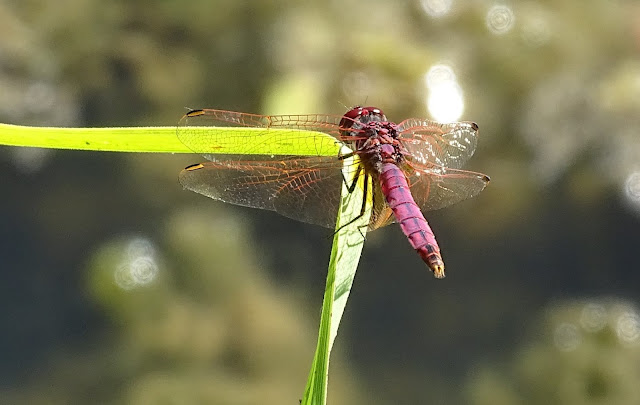It was a surprise to me to find Keeled Skimmer dragonflies at Holt Country Park during three visits of Honeyguide’s Norfolk breaks in September, on 10, 17 and 24 September 2020.
When I submitted these records, I was interested to find out if this was to be expected or out of the ordinary. But first, some notes on what we saw. On 10 September there were several Keeled Skimmers, mostly blue males.
Male Keeled Skimmer, Holt Lowes, 10 September 2020 (David Bennett).
On 17
September, numbers were down to two or three though circumstances allowed a
close view of a dead male trapped in a spider’s web.
 |
| Keeled Skimmer trapped by a four spot orb web spider (Araneus quadratus), Holt County Park (=Holt Lowes SSSI), 17 September 2020 (Chris Durdin). |
Finding one a week later still was a surprise, well into the second half of the month: Jean Dunn’s photograph shows the male on that date.
 |
| Male Keeled Skimmer, Holt Lowes, 24 September 2020 (Jean Dunn). The tiny round leaves are bog pimpernel. |
As the British Dragonfly Society (BDS) puts it, the usual habitat for Keeled Skimmer is “pools and streams in wet heathland sites”, and it has a largely westerly distribution in the UK. However, it occurs on some wet heaths in Norfolk, including three in the eastern half of the county. The map on the NBN Atlas gives a feel for this disjunct distribution.
The main flight
period shown in Smallshire & Swash is June, July and August, with light shading
shown in May and September, indicating less likely periods. So how about
September records in Norfolk?
Pam Taylor, BDS recorder for Norfolk,
says: “I've
checked back over the past 10 years, and I've plenty of late August records,
plus September records for 2010, 2011, 2013, 2019 and 2020. The count was 'D'
in 2010 and 'C' in 2011 [D is 21-100 individuals, C is 6-20], but both were
early in the month. In 2013 there's just two records of singles on 4th
and 8th September. It's not until 2019 that I get good numbers seen into mid-September
and I've one other 2020 record for 7th September in addition to
yours. Your records are therefore quite late for the species. That said,
several other species, like Emperor and Southern Hawker, were also noted as
particularly late-flying this year, so maybe it was weather related.
The visits to
Holt Country Park – Holt Lowes SSSI is how it’s often known in the wildlife
world – were all in the afternoon, in all cases having been at Buxton Heath
during the morning. Buxton Heath is another site for Keeled Skimmers; the photograph
of a female below was taken there in June 2018. We were in the area of Buxton Heath where they occur, towards the end of the morning in good weather conditions, so there is a fair
chance we would have seen one if they were still on the wing.

Female Keeled Skimmer, Buxton Heath, 21 June 2018 (Chris Durdin). The 'keel' refers to the raised line along the abdomen.
Absent in
September also seems to apply to Beeston and Sheringham Commons, a third Norfolk
area where there are Keeled Skimmers. Francis Farrow is the man on the spot
there, and he reports: “On Beeston Common I have checked back over the last 10
years and found 28 August in 2015/16/17 were the latest dates I have. Holt
Lowes is tucked away over the ridge so I expect it would be a warmer site than
Beeston, which may have an influence on the species. At Beeston the Keeled
Skimmers were present 1989-91 then 'disappeared'. One male was seen in 2002 but
it is from 2006 that the present colony has arisen. They are present in good
numbers and have spread throughout Beeston and Sheringham Commons.”
Francis also
says that many years ago (in the 1980s) that he came across a male Keeled
Skimmer trapped by a greater sundew at Holt Lowes. Round-leaved sundews were
quite a feature of Honeyguide’s September visits to Holt Lowes. To see the
scarcer of the two carnivorous sundew species trapping a scarce and local
dragonfly is quite a record.
So the broad
conclusion is that these were late records, a combination of September’s warm
weather and perhaps a micro-climate effect at Holt Lowes playing their part.
What about
away from Norfolk? I asked two Honeyguiders in Cornwall if they recalled seeing
Keeled Skimmers in September, and neither did. As David Collins said, that
might simply be down to not going to the right places at the right time.
These were
not Honeyguide’s first September Keeled Skimmers. In the Dordogne on 19
September 2019 (report here), there were
Keeled Skimmers by pond at Pressignac, photographed by Kate Dalziel ‘in cop’,
which goes to show that weather extends the breeding season. At the time, it
has to be said, their presence was rather outshone by more glamourous southern
species, namely Broad Scarlets (a.k.a. Scarlet Darters) and especially Violet
Dropwing, once an African dragonfly that has moved farther north in recent
years. And a good excuse to show a picture of this gorgeous dragonfly.
 |
| A pair of Keeled Skimmers in the Dordogne, 19 September 2019 (Kate Dalziel). |
 |
| Violet Dropwing, the Dordogne, 19 September 2019 (Ann Greenizan). |
A quick check
of some records from Crete reveals Keeled Skimmers at Turkish Bridge near Monٕí Préveli on 1 May 2016 (report here) though
Southern Skimmer is more usual in our late April visits.
Reference: Britain’s Dragonflies, A Field Guide to the damselflies and dragonflies of Great Britain and Ireland by Dave Smallshire and Andy Swash (WildGuides).





Kate Dalziel adds, having asked the local recorder in Cornwall, that keeled skimmers are around in Cornwall in September and even early October.
ReplyDelete